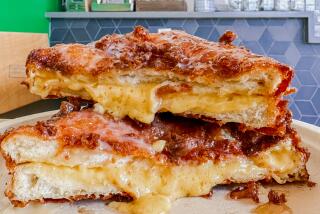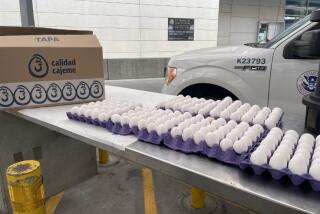Egg Personified the Coming of Spring : A Universal Symbol of Life--Eggs Have Long History
There is a wide assortment of folklore that can be retold to add to the fun of coloring eggs on Easter. The stories reach into pre-Christian times and cross religious beliefs, since eggs throughout history have been a universal symbol of and source of life.
Some cultures abstained from eating them during Lent as a form of sacrifice and discipline. They then decorated them, in some cases exchanging them with each other for good luck, and returned them to the diet for the Easter feast--a celebration of the Resurrection of Christ.
The pre-Christian Ukrainians thought the egg personified the coming of spring--a celebration of the rebirth after the long death of nature in winter. They began to follow the pagan ritual of coloring eggs as a form of thanking the sun for warming the Earth--an event that ultimately became an essential component of Easter celebrations as they are known today.
The following “egg-citing” facts and fables are from the California Egg Commission.
The Egyptians, Greeks, Romans and other ancient civilizations held an assortment of beliefs regarding the egg and its powers. They thought the universe was created from a mother egg or great world and as a result used eggs in their sacrifices and in festivals, sometimes breaking them on the alter of an irritated god as a gesture of apology.
Many ancient philosophers were in awe of the egg because they believed it to be an emblem of the world and the four elements: the white equaled water; the yolk, fire; the shell, earth; and air was signified by the space under the shell.
Once, after a Roman man dreamed he ate an egg, he consulted a soothsayer for an explanation. The soothsayer told him the egg white signified that he would soon obtain some silver and the yolk meant he would receive gold. Not long after this prediction, the man acquired a legacy of silver and gold. He then went back to the soothsayer to thank him and offer a piece of silver. “This is very well for the white,” said the soothsayer, “but is there nought for the yolk?”
The egg has been lauded for its prolific powers as well. In the 17th Century French brides broke an egg on the doorstep of their new homes before entering to guarantee a large family and good fortune. Similarly, German and Slav peasants smeared their plows with an egg, flour and bread mixture on the Thursday before Easter in hopes of improving their harvest.
Decorating eggs as gifts has been practiced by almost every ancient agricultural civilization throughout Europe and Asia. The new year was celebrated by dyeing eggs different colors and giving them as gifts. And following the Lenten abstinence, large amounts of eggs blessed on Easter eve were delivered to friends and family as a special treat on Easter Sunday.
The Russian czars celebrated Easter by giving elaborate jeweled eggs designed by goldsmith Carl Faberge between the 1880s and 1917. In other cultures, as part of the Easter celebration, pyramids of gilded and beautifully painted eggs were presented to the King’s cabinet following the high mass.
A number of contemporary games and activities have replaced many of the ancient religious and cultural customs. Today’s games include the egg hunt, in which colored or decorated eggs are hidden around the house or garden for youngsters to find. Another game is the egg toss; here, partners are lined up in two rows facing each other. Each member on one side tosses a raw egg across to the other side. After each successful catch the players step backward, adding to the difficulty, repeating this process until the couple with the last unbroken egg wins. In egg rolling, a game reminiscent of one that European children once played, eggs are rolled downhill and the last child with an unbroken egg is the winner. In other versions players push their eggs to the finish lines with their noses, or try to send eggs across the finish line by fanning them with cardboard or blowing on them.
The following recipes are designed to use all the leftover colored eggs from whichever activity is chosen to celebrate Easter this year.
CUBAN EGGS
8 hard-cooked eggs
1 cup shredded sharp Cheddar cheese
3 tablespoons half and half or milk
1/2 teaspoon salt
Dash pepper
1/2 cup chopped onion
1/2 cup chopped green pepper
2 tablespoons butter or margarine
1 (16-ounce) can tomato sauce
Hot cooked rice
Parsley sprigs, optional
Cut eggs in half lengthwise. Remove yolks and set whites aside. Mash yolks with fork. Blend in 1/2 cup cheese, half and half, salt and pepper. Refill whites by using 1 heaping tablespoon yolk mixture for each egg half.
Saute onion and green pepper in butter or medium heat until tender but not brown, about 3 minutes. Stir in tomato sauce and bring to boil. Pour over eggs and sprinkle with remaining cheese. Bake at 350 degrees until hot and bubbly and cheese is melted, about 15 minutes. Serve over rice, garnished with parsley. Makes 4 servings.
SKILLET POTATOES WITH BROCCOLI AND EGGS
1 package au gratin potato mix
3 cups water
1 cup milk
2 tablespoons butter or margarine
2 cups chopped broccoli
1 tablespoon prepared mustard
1 (2-ounce) jar sliced pimiento, drained
8 hard-cooked eggs, sliced
Combine packaged potato slices, contents of seasoning mix envelope, water, milk and butter. Bring to boil, stirring occasionally. Cook and stir 5 minutes over medium heat. Add broccoli and mustard. Cover and simmer 15 minutes, stirring occasionally. Carefully fold in pimiento and eggs. Cover and cook an additional 10 minutes, stirring occasionally. Makes 4 servings.
PICK UP AND RUN EGG SALAD
3 tablespoons bottled green goddess dressing
1/8 teaspoon garlic salt
4 hard-cooked eggs, chopped
1/2 cup shredded carrots
2 tablespoons minced green onions
6 large pasta shells, cooked
Blend together dressing and garlic salt. Add eggs, carrots and onions. Gently toss until ingredients are evenly coated with dressing. Spoon 1/4 cup mixture into each pasta shell. Cover and chill to blend flavors. Makes 2 servings.
EGG CHAMPIGNONS
24 large mushrooms, about 1 1/2-inches diameter
6 hard cooked eggs, finely chopped
1/4 cup fine dry bread crumbs
1/4 cup crumbled bleu cheese
2 tablespoons finely chopped green onions
2 tablespoons dry white wine
2 tablespoons butter or margarine, melted
1 tablespoon snipped parsley
1/2 teaspoon garlic salt
Paprika, optional
Remove stems from mushrooms and set aside for another use. Set mushroom caps aside.
Combine eggs, bread crumbs, cheese, onions, wine, butter, parsley and garlic salt. Fill each mushroom cap with rounded tablespoon mixture. Place on lightly greased baking sheet. Bake at 450 degrees until heated through, 8 to 10 minutes. Sprinkle with paprika. Makes 6 appetizer servings of 4 mushrooms each.
HAM, EGG AND SCALLOPED POTATO BAKE
1 package cheese scalloped potato mix
2 1/4 cups boiling water
2/3 cup milk
2 tablespoons butter or margarine
1 cup cubed, cooked ham
1/4 cup chopped green pepper
4 hard-cooked eggs
2 tablespoons mayonnaise
Pour potato slices into ungreased 2-quart casserole. Sprinkle with seasoning mix. Stir in water, milk, butter, ham and green pepper. Bake uncovered at 400 degrees 25 minutes.
Meanwhile, slice eggs in half lengthwise. Remove yolks and place in small bowl. Mash yolks with fork and add mayonnaise. Mix until fluffy. Fill egg white halves with yolk mixture. Arrange on top of potatoes. Bake additional 10 to 15 minutes or until potatoes are tender. Makes 4 servings.
More to Read
Eat your way across L.A.
Get our weekly Tasting Notes newsletter for reviews, news and more.
You may occasionally receive promotional content from the Los Angeles Times.










